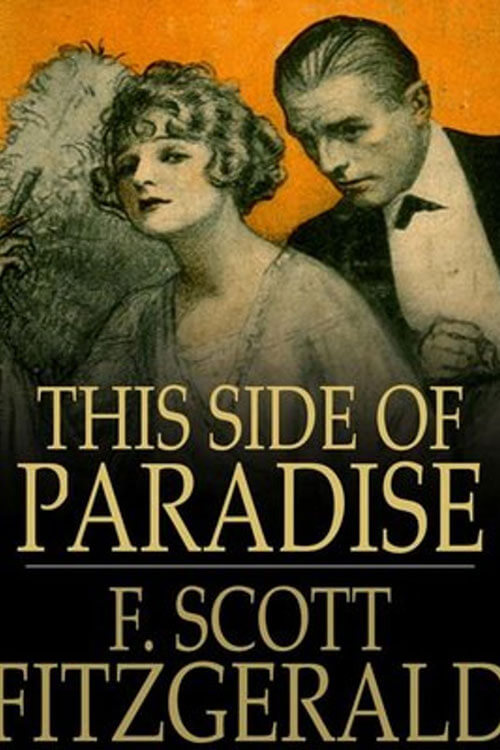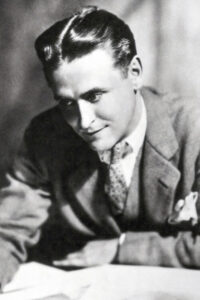
This Side of Paradise
Amory gradually accepted this point of view, decided that next fall would inaugurate his career, and relinquished himself to watching Kerry extract joy from 12 Univee.
They filled the Jewish youth’s bed with lemon pie; they put out the gas all over the house every night by blowing into the jet in Amory’s room, to the bewilderment of Mrs. Twelve and the local plumber; they set up the effects of the plebeian drunks—pictures, books, and furniture—in the bathroom, to the confusion of the pair, who hazily discovered the transposition on their return from a Trenton spree; they were disappointed beyond measure when the plebeian drunks decided to take it as a joke; they played red-dog and twenty-one and jackpot from dinner to dawn, and on the occasion of one man’s birthday persuaded him to buy sufficient champagne for a hilarious celebration. The party donor has remained sober. Kerry and Amory accidentally dropped him down two flights of stairs and called, shame-faced and penitent, at the infirmary all the following week.
“Say, who are all these women?” Kerry demanded one day, protesting the size of Amory’s mail. I’ve been looking at the postmarks lately—Farmington and Dobbs and Westover and Dana Hall—what’s the idea?”
Read or download Book
F. Scott Fitzgerald
Francis Scott Key Fitzgerald (September 24, 1896 – December 21, 1940) was an American novelist, essayist, and short story writer.
Biography.
He is best known for his novels depicting the flamboyance and excess of the Jazz Age—a term he popularized in his short story collection Tales of the Jazz Age. During his lifetime, he published four novels, four story collections, and 164 short stories. Although he achieved temporary popular success and fortune in the 1920s, Fitzgerald received critical acclaim only after his death and is now widely regarded as one of the greatest American writers of the 20th century.
Born into a middle-class family in Saint Paul, Minnesota, Fitzgerald was raised primarily in New York. He attended Princeton University, where he befriended future literary critic Edmund Wilson. Owing to a failed romantic relationship with Chicago socialite Ginevra King, he dropped out in 1917 to join the United States Army during World War I. While stationed in Alabama, he met Zelda Sayre, a Southern debutante who belonged to Montgomery’s exclusive country club set. Although she initially rejected Fitzgerald’s marriage proposal due to his lack of financial prospects, Zelda agreed to marry him after he published the commercially successful This Side of Paradise (1920). The novel became a cultural sensation and cemented his reputation as one of the eminent writers of the decade.
His second novel, The Beautiful and Damned (1922), propelled him further into the cultural elite. He wrote numerous stories for popular magazines such as The Saturday Evening Post, Collier’s Weekly, and Esquire to maintain his affluent lifestyle. During this period, Fitzgerald frequented Europe, where he befriended modernist writers and artists of the “Lost Generation” expatriate community, including Ernest Hemingway. His third novel, The Great Gatsby (1925), received generally favourable reviews but was a commercial failure, selling fewer than 23,000 copies in its first year. Despite its lacklustre debut, The Great Gatsby is now hailed by some literary critics as the “Great American Novel”. Following the deterioration of his wife’s mental health and her placement in a mental institute for schizophrenia, Fitzgerald completed his final novel, Tender Is the Night (1934).
Struggling financially because of the declining popularity of his works during the Great Depression, Fitzgerald moved to Hollywood, where he embarked upon an unsuccessful career as a screenwriter. While living in Hollywood, he cohabited with columnist Sheilah Graham, his final companion before his death. After a long struggle with alcoholism, he attained sobriety only to die of a heart attack in 1940 at 44. After Fitzgerald’s death, his friend Edmund Wilson edited and published an unfinished fifth novel, The Last Tycoon (1941). In 1993, a new edition was published, The Love of the Last Tycoon, edited by Matthew J. Bruccoli.
Born on September 24, 1896, in Saint Paul, Minnesota, to a middle-class Catholic family, Francis Scott Key Fitzgerald was named after Francis Scott Key, a distant cousin who wrote the lyrics in 1814 for the song “The Star-Spangled Banner”, which later became the American national anthem. His mother was Mary “Molly” McQuillan Fitzgerald, the daughter of an Irish immigrant who became wealthy as a wholesale grocer. His father, Edward Fitzgerald, descended from Irish and English ancestry and had moved to Minnesota from Maryland after the American Civil War to open a wicker furniture manufacturing business. Edward’s first cousin twice removed, Mary Surratt, was hanged in 1865 for conspiring to assassinate Abraham Lincoln.
One year after Fitzgerald’s birth, his father’s wicker furniture manufacturing business failed, and the family moved to Buffalo, New York, where his father joined Procter & Gamble as a salesman. Fitzgerald spent the first decade of his childhood primarily in Buffalo, with a brief interlude in Syracuse between January 1901 and September 1903. His parents sent him to two Catholic schools on Buffalo’s West Side—first Holy Angels Convent (1903–1904) and then Nardin Academy (1905–1908). As a boy, Fitzgerald was described by his peers as unusually intelligent with a keen interest in literature.
Procter & Gamble fired his father in March 1908, and the family returned to Saint Paul. Although his alcoholic father was now destitute, his mother’s inheritance supplemented the family income and allowed them to continue living a middle-class lifestyle. Fitzgerald attended St. Paul Academy from 1908 to 1911. At 13, Fitzgerald had his first piece of fiction published in the school newspaper. In 1911, Fitzgerald’s parents sent him to the Newman School, a Catholic prep school in Hackensack, New Jersey. Father Sigourney Fay recognized his literary potential at Newman and encouraged him to become a writer.






